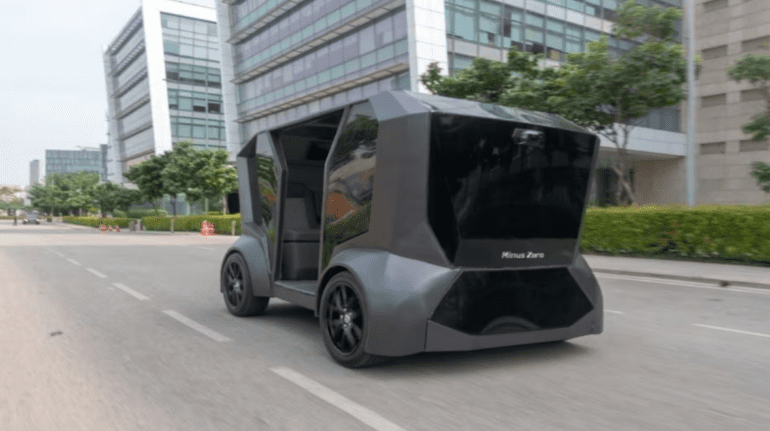TL;DR:
- Minus Zero, an AI-based self-driving tech start-up, has introduced India’s first fully autonomous vehicle called zPod.
- The vehicle utilizes a camera-sensor suite and operates under all environmental and geographical constraints.
- zPod has Level 5 autonomy, capable of operating without human intervention in all driving conditions.
- The start-up raised $1.7 million in seed funding from investors in the autonomous vehicles industry.
- The camera-based approach makes zPod more affordable compared to vehicles with expensive sensor arrays.
- Initially, zPod’s use was limited to in-campus mobility, transporting people within defined areas.
- Minus Zero plans to collaborate with OEMs to enhance their advanced driver-assistance systems (ADAS).
- The company focuses on advancing Nature Inspired AI (NIA) and True Vision Autonomy (TVA) technologies.
- Nature-inspired AI offers real-time low-power processing and adaptability to various real-road conditions.
- TVA is a vehicle agnostic technology that relies on cameras for safe navigation and a smooth user experience.
Main AI News:
Minus Zero, an AI-based self-driving tech start-up headquartered in Bengaluru, has introduced India’s inaugural fully autonomous vehicle. Known as zPod, this cutting-edge prototype relies on a sophisticated camera-sensor suite and operates seamlessly within various environmental and geographical constraints. It boasts Level 5 autonomy, the highest level achievable in autonomous driving, which means it can function without any human intervention across all driving conditions and environments.
The brainchild of Gagandeep Reehal and Gursimran Kalra, Minus Zero secured a seed fund of $1.7 million from a group of investors, including Chiratae Ventures, Snow Leopard Ventures, IIT Mandi, and other prominent figures from the autonomous vehicles industry.
Unlike traditional autonomous vehicles, zPod lacks a steering wheel. Instead, it utilizes a network of strategically placed high-resolution cameras as its primary sensory system. These cameras capture real-time images of the vehicle’s surroundings, transmitting them to the AI system. Through advanced processing, the AI system analyzes this information, enabling the vehicle to make well-informed decisions related to navigation, speed control, and obstacle avoidance. This camera-centric approach sets zPod apart as a more cost-effective autonomous vehicle, distinguishing it from those relying on expensive sensor arrays.
Initially, zPod’s applications were limited to in-campus mobility, focusing on transporting individuals within specific areas such as tech parks, university campuses, corporate compounds, or any institution with defined boundaries. Additionally, Minus Zero aims to collaborate with original equipment manufacturers (OEMs) to enhance their advanced driver-assistance systems (ADAS) with their groundbreaking technology.
In an interview with Business Today, the founders clarified that zPod is merely a vehicle designed to showcase the AI-based autonomous vehicle technology developed by the company. They emphasized that Minus Zero does not intend to manufacture cars, stating, “We are not an OEM; we do not plan to build cars. It is a vehicle developed to showcase the system we have built. We believe not one company or country alone can build and develop the concept of an autonomous vehicle; it needs the whole ecosystem to come together. It is just the beginning,” explained Reehal.
Moving forward, Minus Zero will concentrate on advancing its proprietary technologies—Nature Inspired AI (NIA) and True Vision Autonomy (TVA)—to explore numerous opportunities, including partnerships with OEMs for future growth.
Nature-inspired AI employs a physics-aware vision and human brain-inspired predictive decision-making capabilities to build generalized autonomous agents. This approach enables efficient handling of real-world road scenarios, setting it apart from traditional AI. The company states that the nature-inspired algorithm offers real-time low-power processing, adaptability to uncertain or chaotic real-road conditions, and eliminates the need for re-learning driving skills for different use cases, geographies, or vehicles. TVA, on the other hand, is a vehicle agnostic technology, capable of adapting to any use case and vehicle form factor, relying solely on cameras as its sensor suite. This ensures safe navigation through real-world scenarios, providing reliability and a seamless user experience.
“Our concepts allow automakers to explore new design possibilities for vehicles, currently limited by the constraints of a driver-led design. We aim to redefine mobility from a driver-centric hassle to a user-focused experiential design,” stated Kalra confidently.
Conclusion:
Minus Zero’s unveiling of India’s first fully autonomous vehicle, zPod, marks a significant milestone in the market. The camera-based approach, coupled with Level 5 autonomy, offers a more affordable solution compared to vehicles with expensive sensor arrays. This development opens up opportunities for in-campus mobility and collaborations with OEMs to enhance their ADAS.
Minus Zero’s focus on advancing their Nature Inspired AI (NIA) and True Vision Autonomy (TVA) technologies demonstrates their commitment to reshaping the future of autonomous vehicles and redefining mobility experiences. This innovation has the potential to drive further advancements in the market and foster the growth of the autonomous vehicle ecosystem.

